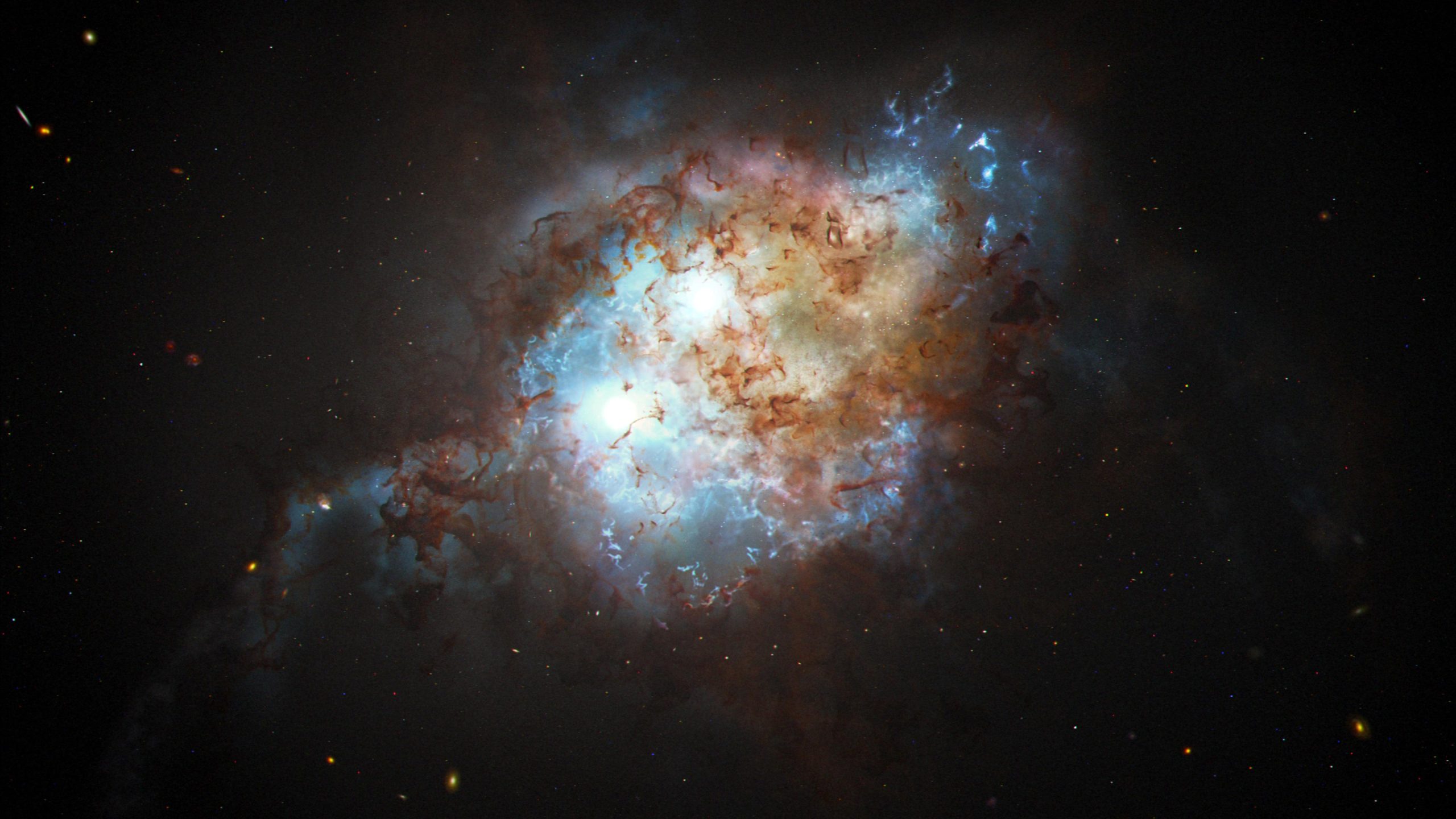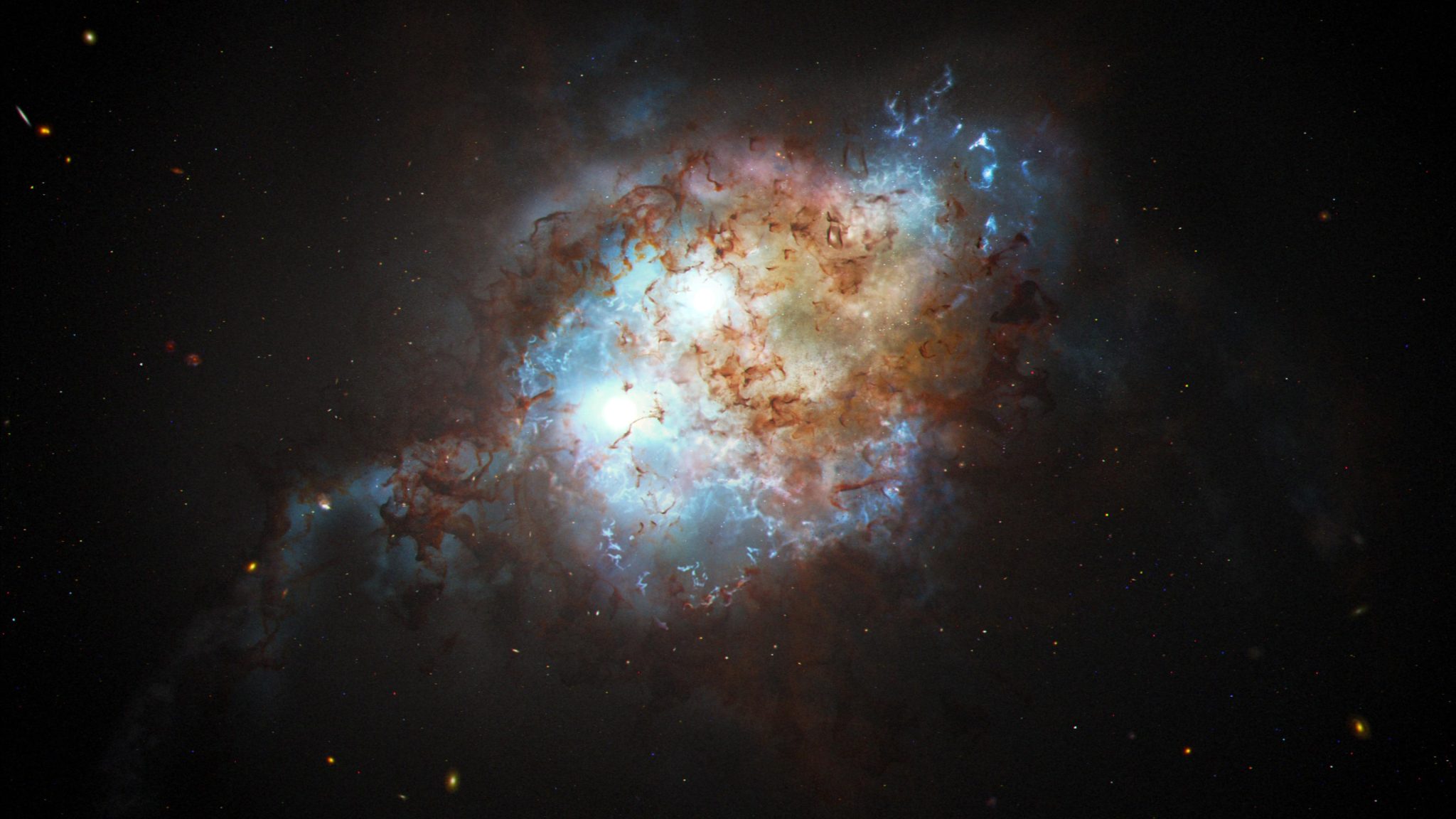

Ez a művész koncepciója két kvazár fényes ragyogását mutatja be két galaxis szívében az egyesülés kaotikus folyamatában. A két galaxis között zajló huzavona csillagszületési vihart robbantott ki. A kvazárok a távoli galaxisok központjaiból származó intenzív fény ragyogó jelzőfényei. Szupermasszív fekete lyukak hajtják őket, amelyek mohón táplálkoznak a behulló anyagokkal. Ez a tápláló őrület olyan sugárzásáradat szabadít fel, amely felülmúlhatja a befogadó galaxis csillagainak milliárdjainak együttes fényét. Néhány tízmillió éven belül a fekete lyukak és galaxisaik, valamint a kvazárpár egyesülni fognak, és egy még nagyobb tömegű fekete lyukat alkotnak. Köszönetnyilvánítás: NASA, ESA és Joseph Olmsted (STScI)
Egy pár egyesült galaxis fekete lyukakat gyújt be az ütközési pályán
A kvazárok a világegyetem legfényesebbjei közé tartoznak. Szétszórva van az égen, és több mint 100 milliárd csillag gazdagságában ragyog. És mint egy fényes július 4-i légköri fáklya, viszonylag rövid ideig világítanak – kozmikus időskálán. Ennek az az oka, hogy szupermasszív fekete lyukak hajtják őket, amelyek sok gázt és port nyelnek el, ami magas hőmérsékletre melegszik fel. De a kvazár ételbüfé csak ennyi ideig tart.
A kvazárok ezen múlandó tulajdonsága segített a csillagászoknak két olyan kvazár megtalálásában, amelyek ütközési pályán vannak egymással. Egy galaxispárba ágyazódik be, amelyek 10 milliárd éve ütköztek egymással. Ritkán találni ilyen lendületes párost a távoli univerzumban. A felfedezés nyomokat ad arra vonatkozóan, milyen instabil volt az univerzum régen, amikor a galaxisok gyakran ütköztek, és a fekete lyukak hemzsegtek a közeli találkozásokból származó törmelékektől és sugárhajtásoktól.
Mivel a két kvazár különböző sebességgel villog, ahogy a tüzelőanyag-gyertyák beáramlása csökken, az űrben előforduló szokatlan tevékenységként azonosították őket. A Hubble ráközelített és egyértelműen felbontotta a képet, akárcsak a gazdagalaxisok.

A Hubble Űrteleszkóp képe egy kvazárpárról, amely akkor létezett, amikor az univerzum még csak 3 milliárd éves volt. Egy pár ütköző galaxisba ágyazódik be. A kvazárokat egynél kisebb galaxis választja el egymástól. A kvazárokat vad szupermasszív fekete lyukak hajtják, amelyek vad energiaforrásokban törnek ki, miközben megfulladnak a gáztól, a portól és bármi mástól, ami a gravitációs hatókörükbe kerül. A fekete lyukak végül összeolvadnak. Köszönetnyilvánítás: NASA, ESA, Yu-Ching Chen (UIUC), Hsiang-Chih Huang (IAS), Nadja Zakamska (JHU), Yu Chen (UIUC)
A Hubble Űrteleszkóp váratlanul kettős kvazárt talál egy távoli univerzumban
A korai univerzum ingatag hely volt, ahol a galaxisok ütköztek egymással, sőt összeolvadtak. Használat[{” attribute=””>NASA’s Hubble Space Telescope and other space and ground-based observatories, astronomers investigating these developments have made an unexpected and rare discovery: a pair of gravitationally bound quasars, both blazing away inside two merging galaxies. They existed when the universe was just 3 billion years old.
Quasars are bright objects powered by voracious, supermassive black holes blasting out ferocious fountains of energy as they engorge themselves on gas, dust, and anything else within their gravitational grasp.
“We don’t see a lot of double quasars at this early time in the universe. And that’s why this discovery is so exciting,” said graduate student Yu-Ching Chen of the University of Illinois at Urbana-Champaign, lead author of this study.
Finding close binary quasars is a relatively new area of research that has just developed in the past 10 to 15 years. Today’s powerful new observatories have allowed astronomers to identify instances where two quasars are active at the same time and are close enough that they will eventually merge.
There is increasing evidence that large galaxies are built up through mergers. Smaller systems come together to form bigger systems and ever larger structures. During that process there should be pairs of supermassive black holes formed within the merging galaxies. “Knowing about the progenitor population of black holes will eventually tell us about the emergence of supermassive black holes in the early universe, and how frequent those mergers could be,” said Chen.

This compass image shows a Hubble Space Telescope photograph of a pair of quasars that existed when the universe was just 3 billion years old. They are embedded inside a pair of colliding galaxies. The quasars are separated by less than the size of a single galaxy. Quasars are powered by voracious, supermassive black holes blasting out ferocious fountains of energy as they engorge themselves on gas, dust, and anything else within their gravitational grasp. The black holes will eventually merge. Credit: NASA, ESA, Yu-Ching Chen (UIUC), Hsiang-Chih Hwang (IAS), Nadia Zakamska (JHU), Yue Shen (UIUC)
We’re starting to unveil this tip of the iceberg of the early binary quasar population,” said Xin Liu of the University of Illinois at Urbana-Champaign. “This is the uniqueness of this study. It is actually telling us that this population exists, and now we have a method to identify double quasars that are separated by less than the size of a single galaxy.”
This was a needle-in-haystack search that required the combined power of NASA’s Hubble Space Telescope and the W.M. Keck Observatories in Hawaii. Multi-wavelength observations from the International Gemini Observatory in Hawaii, NSF’s Karl G. Jansky Very Large Array in New Mexico, and NASA’s Chandra X-ray Observatory also contributed to understanding the dynamic duo. And, ESA (European Space Agency)’s Gaia space observatory helped identify this double quasar in the first place.
“Hubble’s sensitivity and resolution provided pictures that allow us to rule out other possibilities for what we are seeing,” said Chen. Hubble shows, unequivocally, that this is indeed a genuine pair of supermassive black holes, rather than two images of the same quasar created by a foreground gravitational lens. And, Hubble shows a tidal feature from the merging of two galaxies, where gravity distorts the shape of the galaxies forming two tails of stars.
However, Hubble’s sharp resolution alone isn’t good enough to go looking for these dual light beacons. The researchers enlisted Gaia, which launched in 2013, to pinpoint potential double-quasar candidates. Gaia measures the positions, distances, and motions of nearby celestial objects very precisely. But in a novel technique, it can be used to explore the distant universe. Gaia’s huge database can be used to search for quasars that mimic the apparent motion of nearby stars. The quasars appear as single objects in the Gaia data because they are so close together. However, Gaia can pick up a subtle, unexpected “jiggle” that mimics an apparent change in position of some of the quasars it observes.
In reality, the quasars aren’t moving through space in any measurable way. Instead, their jiggle could be evidence of random fluctuations of light as each member of the quasar pair varies in brightness on timescales of days to months, depending on their black hole’s feeding schedule. This alternating brightness between the quasar pair is similar to seeing a railroad crossing signal from a distance. As the lights on both sides of the stationary signal alternately flash, the sign gives the illusion of “jiggling.”
Another challenge is that because gravity warps space like a funhouse mirror, a foreground galaxy could split the image of a distant quasar into two, creating the illusion it was really a binary pair. The Keck telescope was used to make sure there was no lensing galaxy in between us and the suspected double quasar.
Because Hubble peers into the distant past, this double quasar no longer exists. Over the intervening 10 billion years, their host galaxies have likely settled into a giant elliptical galaxy, like the ones seen in the local universe today. And, the quasars have merged to become a gargantuan, supermassive black hole at its center. The nearby giant elliptical galaxy, M87, has a monstrous black hole weighing 6.5 billion times the mass of our Sun. Perhaps this black hole was grown from one or more galaxy mergers over the past billions of years.
The upcoming NASA Nancy Grace Roman Space Telescope, having the same visual acuity as Hubble, is ideal for binary quasar hunting. Hubble has been used to painstakingly take data for individual targets. But Roman’s very wide-angle infrared view of the universe is 200 times larger than Hubble’s. “A lot of quasars out there could be binary systems. The Roman telescope can do huge improvements in this research area,” said Liu.
The results will be published in the April 5 journal Nature.
Reference: “A close quasar pair in a disk–disk galaxy merger at z = 2.17” by Yu-Ching Chen, Xin Liu, Adi Foord, Yue Shen, Masamune Oguri, Nianyi Chen, Tiziana Di Matteo, Miguel Holgado, Hsiang-Chih Hwang and Nadia Zakamska, 5 April 2023, Nature.
DOI: 10.1038/s41586-023-05766-6
The Hubble Space Telescope is a project of international cooperation between NASA and ESA. NASA’s Goddard Space Flight Center in Greenbelt, Maryland, manages the telescope. The Space Telescope Science Institute (STScI) in Baltimore, Maryland, conducts Hubble and Webb science operations. STScI is operated for NASA by the Association of Universities for Research in Astronomy, in Washington, D.C.

„Utazási specialista. Tipikus közösségi média tudós. Az állatok barátja mindenhol. Szabadúszó zombinindzsa. Twitter-barát.”





More Stories
A SpaceX Polaris Dawn űrszondájának legénysége a valaha volt legveszélyesebb űrsétára készül
Egy őskori tengeri tehenet evett meg egy krokodil és egy cápa a kövületek szerint
Egyforma dinoszaurusz-lábnyomokat fedeztek fel két kontinensen